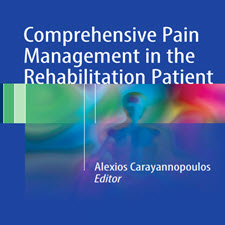Rehabilitative Surgery
ABSTRACT
The paralyzed or severely neurologically impaired patient is one of the greatest challenges in longterm chronic care that we face as clinicians, whether we are therapists or neurologists, physiatrists, or surgeons. Because of the complexity of their treatment and the severity of their injury, these patients may be viewed as a hopeless cause for many physicians, especially surgeons. Optimization of their care – and potentially improvement in quality and length of life – requires a complex and delicate interaction between multiple surgical and medical specialties across disciplines and time. The current state of rehabilitative medicine works to maximize patient function as well as manage the lifelong maintenance required to continue that level of function. Although surgery has always been part of the treatment of the paralyzed patient, it may be seen as an afterthought or the modality of last resort for the rehabilitation community or even surgeons who have little experience taking care of these patients. Once surgery is considered, the procedures needed to care for these patients and improve their lives often exist at the margins of existing surgical specialties or at the junction of multiple disciplines, performed haphazardly without a unifed understanding of a comprehensive treatment approach. These procedures and their context may be diffcult to understand, requiring familiarity with different interlocking yet distinct specialties, making approaching this topic particularly daunting for the student of any feld.
INTRODUCTION
Once an injury is sustained, the body’s metabolism shifts toward a state with higher metabolic expenditure. Understanding the changes that occur in amino acid, carbohydrate, and lipid metabolism allows the physician and care team to provide optimal nutritional support for the surgical patient . In a healthy adult, approximately 22–25 kcal/kg per day are required to maintain basic metabolic needs. This requirement can increase to up to 40 kcal/kg in patients that have undergone severe stress and injury (Table 2.1). This stress response is triggered by the release of catecholamines and sympathetic activation. Furthermore, during the fasting state, a signifcant amount of protein is used to provide the substrate for gluconeogenesis in the liver leading to muscle wasting as the body enters a catabolic state . The magnitude of protein catabolism is directly proportional to the severity of the injury with even elective operations and minor injuries leading to decreased protein synthesis and protein breakdown.
چکیده
بیمار مبتلا به فلج یا به شدت عصبی، یکی از بزرگترین چالش های مراقبت های طولانی مدت مزمن است که ما با پزشکان روبرو می شویم، چه اینکه ما درمانگران یا متخصصان اعصاب، متخصصان جراحی و یا جراحان هستیم. به دلیل پیچیدگی درمان و شدت آسیب آنها، ممکن است این بیماران به عنوان یک علت ناامید برای بسیاری از پزشکان، به ویژه جراحان باشد. بهینه سازی مراقبت از خود – و به طور بالقوه بهبود کیفیت و طول عمر – نیاز به تعامل پیچیده و ظریف بین تخصص های متعدد جراحی و پزشکی در سراسر رشته ها و زمان. وضعیت فعلی داروهای توانبخشی برای به حداکثر رساندن عملکرد بیمار و همچنین مدیریت نگهداری طول عمر مورد نیاز برای ادامه این سطح فعالیت می کند. اگرچه جراحی همواره بخشی از درمان بیمار فلج شده است، اما ممکن است به عنوان یک تصور بعد از آن یا شیوهی آخرت برای جامعه توانبخشی یا حتی جراحان که تجربه کمی از این بیماران دارند، دیده شود. هنگامی که عمل جراحی در نظر گرفته می شود، روش های مورد نیاز برای مراقبت از این بیماران و بهبود زندگی آنها اغلب در حاشیه جراحی های جراحی وجود دارد و یا در ترکیب رشته های متعدد، به طور تصادفی بدون درک یکپارچه از یک روش درمان جامع. این رویه ها و زمینه های آنها ممکن است برای فهمیدن مشکل باشد، و نیازمند آشنایی با تخصص های متمایز و متمایز مختلف است، و این موضوع برای دانش آموزان هر فلده بسیار مناسب است.
مقدمه
هنگامی که یک آسیب پایدار است، متابولیسم بدن به سمت یک کشور با هزینه های متابولیک بالاتر حرکت می کند. درک تغییراتی که در متابولیسم آمینو اسید، کربوهیدرات و لیپید اتفاق می افتد، به پزشک و تیم مراقبت کمک می کند تا حمایت های تغذیه ای مطلوب را برای بیمار جراحی فراهم کند. در بزرگسالان سالم تقریبا 22-25 کیلو کالری / کیلوگرم در روز برای حفظ نیازهای متابولیک اولیه ضروری است. این نیاز می تواند تا 40 کیلو کالری / کیلوگرم در بیماران دچار استرس و آسیب شدید افزایش یابد (جدول 2.1). این پاسخ استرس ناشی از آزاد شدن کاتلول آمین ها و فعال سازی سمپاتیک است. علاوه بر این، در حالت ناشتا، مقدار قابل توجهی از پروتئین برای فراهم کردن بستر برای گلوکونوژنز در کبد منجر به اتلاف عضلانی به عنوان بدن وارد یک وضعیت کاتابولیک می شود. مقدار کاتابولیسم پروتئین به طور مستقیم با شدت آسیب و حتی عملیات انتخابی و آسیب های جزئی همراه است که منجر به کاهش سنتز پروتئین و تجزیه پروتئین می شود.
Year: 2016
Publisher: SPRINGER
By : Andrew I. Elkwood, Matthew Kaufman , Lisa F. Schneider
File Information: English Language/ 390 Page / size: 12.30 MB
سال : 1395
ناشر : SPRINGER
کاری از : اندرو اول الكوود، متی كوفمن، لیزا فاشی اسنایدر
اطلاعات فایل : زبان انگلیسی / 390 صفحه / حجم : MB 12.30

![Rehabilitative.Surgery.A.Comprehensive.[taliem.ir]](https://taliem.ir/wp-content/uploads/Rehabilitative.Surgery.A.Comprehensive.taliem.ir_.jpg)


![Pulse.Waves.How.Vascular.Hemodynamics.[taliem.ir]](https://taliem.ir/wp-content/uploads/Pulse.Waves_.How_.Vascular.Hemodynamics.taliem.ir_-150x150.jpg)
![Retinal.Pigment.Epithelial.Detachment.[taliem.ir]](https://taliem.ir/wp-content/uploads/Retinal.Pigment.Epithelial.Detachment.taliem.ir_-150x150.jpg)
دیدگاه خود را ثبت کنید
تمایل دارید در گفتگو شرکت کنید؟نظری بدهید!